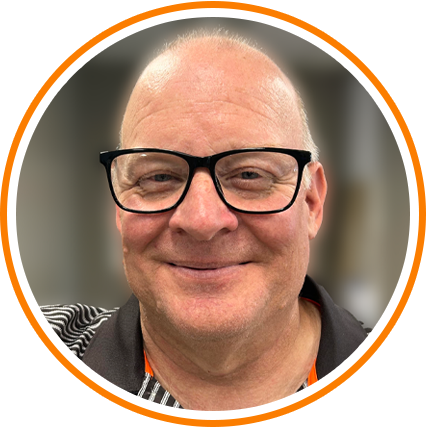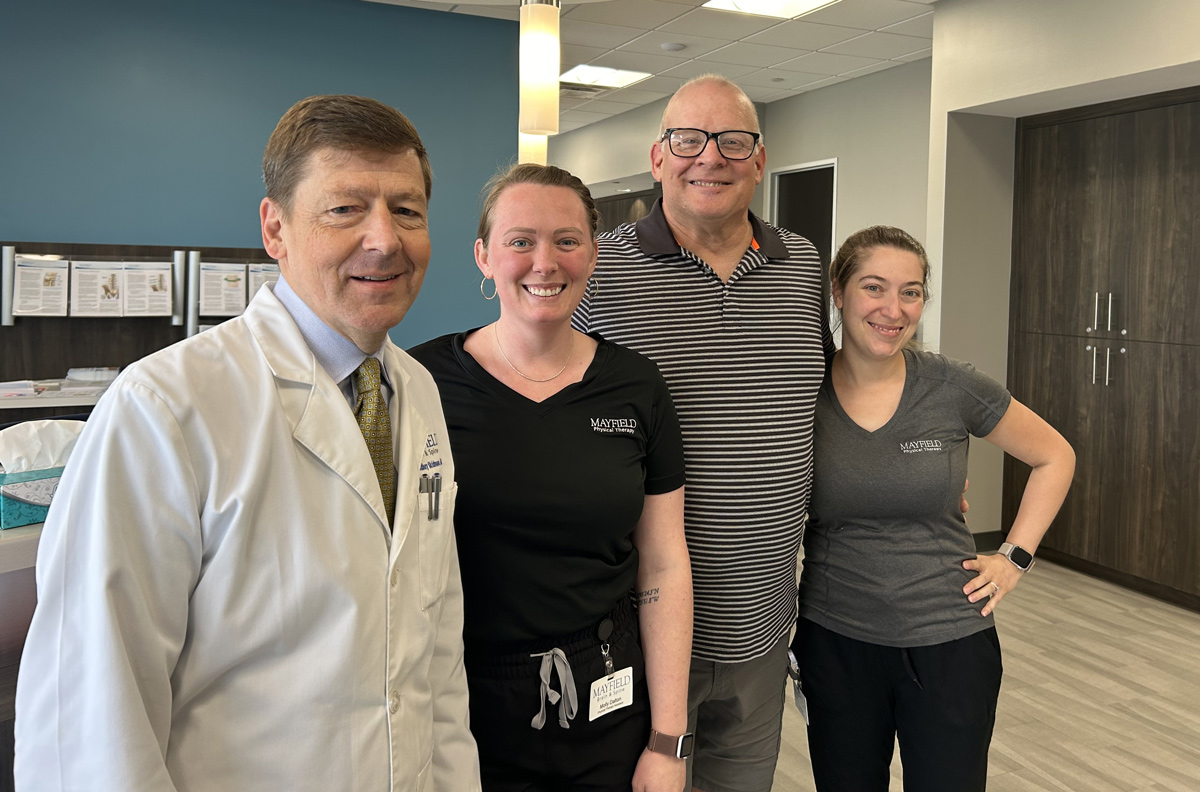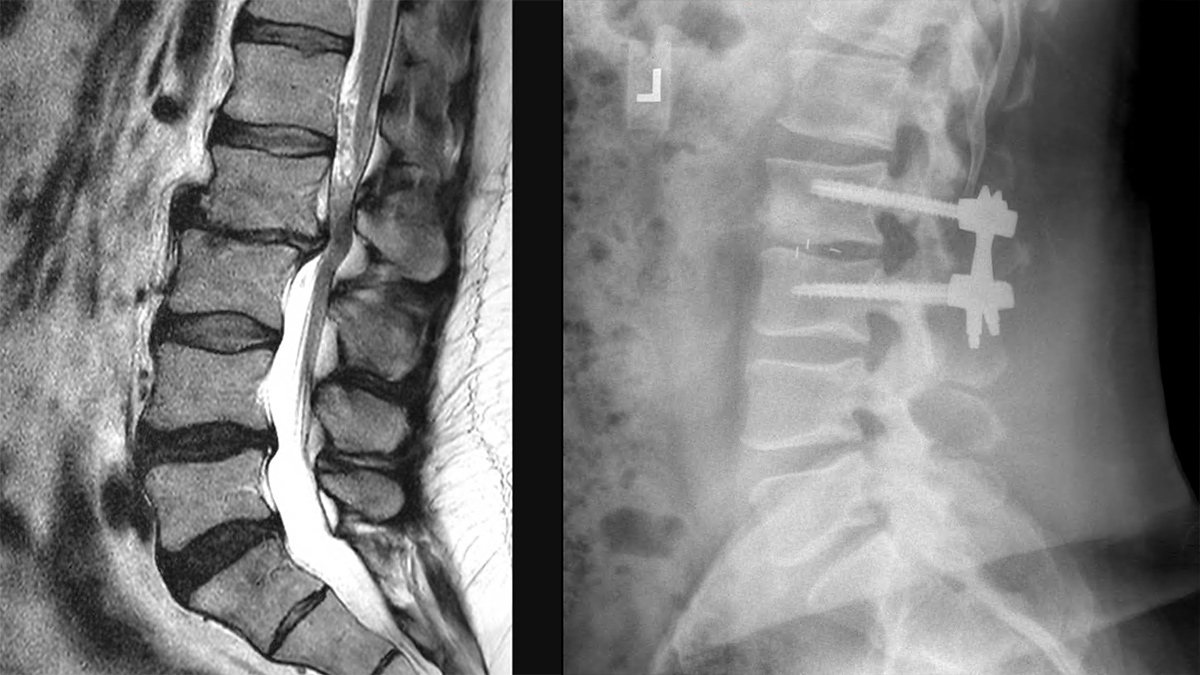
Pete’s story
Degenerative disc disease, spondylolisthesis, TLIF
Outpatient spine surgery, physical therapy fuel Pete’s recovery
Gradually after his spine surgery, Pete has regained his strength and reduced his pain. First, he moved with a walker, then a cane. Pretty soon, he was walking around on his own, then driving. Fueled by regular physical therapy sessions, he finally returned to work as a deputy in a Northern Kentucky sheriff’s department.
“I can tell that I’m making progress,” he says. “I really wish I would have had the surgery sooner. I don’t think I ever really comprehended what the pain would be like.”
After a lifetime of sports and hunting – plus carrying around a vest and gun belt that can weigh as much as 30 pounds – Pete had been dealing with some level of pain for several years. Periodic injections had helped control the symptoms. At its worst, the pain extended down to his hips and thighs. Eventually, it worsened to a point where he was using a wheelchair in his own house.
“There were times when my leg just started to collapse,” he says.
 Pete with his Mayfield care team: Dr. Brad Skidmore, physical therapist assistant Molly Dalton and physical therapist Danielle Kelly.
Pete with his Mayfield care team: Dr. Brad Skidmore, physical therapist assistant Molly Dalton and physical therapist Danielle Kelly.
Pete was referred to Dr. Brad Skidmore, a neurosurgeon at Mayfield Brain & Spine’s Crestview Hills office. Images showed that Pete had degenerative disc disease in his lower back, at the L2-L3 levels of his spine. He was suffering from a common condition called spondylolisthesis, when one of the vertebrae slips forward out of normal position, pinching the nearby nerves.
 On the left, the vertebra at L2-L3 slipped out of place in Pete's spine. After surgery with Dr. Brad Skidmore, the right image shows hardware designed to realign the vertebra in correct position and hold it in place while the fusion heals.
On the left, the vertebra at L2-L3 slipped out of place in Pete's spine. After surgery with Dr. Brad Skidmore, the right image shows hardware designed to realign the vertebra in correct position and hold it in place while the fusion heals.
Dr. Skidmore recommended a procedure called a laminectomy to decompress the nerves. Then he would insert pedicle screws into the bones above and below the bone that has slipped forward, before pulling the bones back into alignment and securing the repaired section with a rod. Bone graft would allow the two bones to fuse together in a procedure called a transforaminal lumbar interbody fusion, or TLIF.
“Spondylolisthesis is not unusual among men older than 40 who have put too much stress on their lumbar spine,” Dr. Skidmore says. “That stress doesn’t always result in surgery, but Pete’s symptoms had become severe. We were able to realign the spine to allow the nerves space to heal. With physical therapy, he has been able to get back to many of his normal daily activities.”
Dr. Skidmore operated on Pete’s back at the Mayfield Spine Surgery Center in Norwood. Launched by Mayfield in 2007, it is one of the most established freestanding centers in the country for outpatient surgeries, when patients don’t have to spend the night in a hospital. Less than a day after the surgery, Pete was recovering at home.
The hardest work came two weeks after surgery, when Pete started working with physical therapist Danielle Kelly and physical therapist assistant Molly Dalton at Mayfield’s office in Crestview Hills. He came into his first session with a rolling walker, and at the end, he was barely able to stand. He said the rigorous sessions were sometimes difficult, but always moved him toward his goals.
Kelly says Pete’s gait needed work because of a previous medical condition, and that the iliopsoas muscle in his hip was extremely tight. While his pain level decreased quickly, improving his balance and strength so he could walk freely took most of the twice-a-week therapy sessions that lasted for several months.
Beyond the traditional stretching and strengthening, Kelly used techniques such as dry needling, inserting a thin needle at various “trigger points” to stimulate the muscles, increase blood flow and speed the healing process.
“Pete wanted to get back to work and back to walking on his own,” the physical therapist says. “He had a little different gait pattern in that leg to begin with, so trying to get back to normal walking was a bit of a challenge.”
Pete’s motivation to exercise at home was a big factor in his recovery.
“We never had to worry about what he was doing,” Kelly said. “He was getting things done.”
Thinking back to his first meeting with Dr. Skidmore, Pete remembers that the physician made it clear that surgery could help him.
“He told me, ‘It’s going to get worse, but we can fix it. You’ll know when it’s time,’” Pete recalls. “I want my doctor to be direct and matter-of-fact and confident. Dr. Skidmore is all of those things.”
~ Cliff Peale
Hope Story Disclaimer -"Pete's Story" is about one patient's health-care experience. Please bear in mind that because every patient is unique, individual patients may respond to treatment in different ways. Results are influenced by many factors and may vary from patient to patient.
